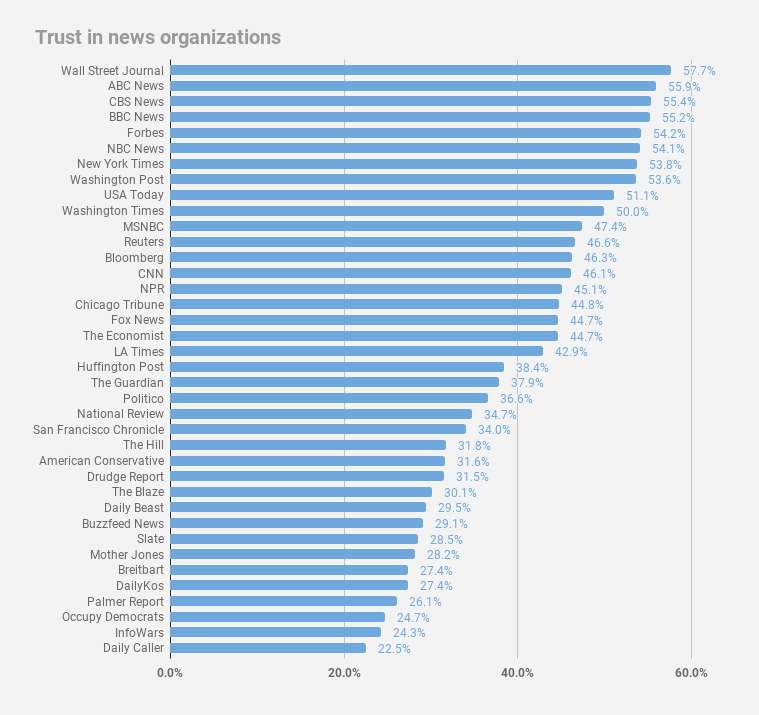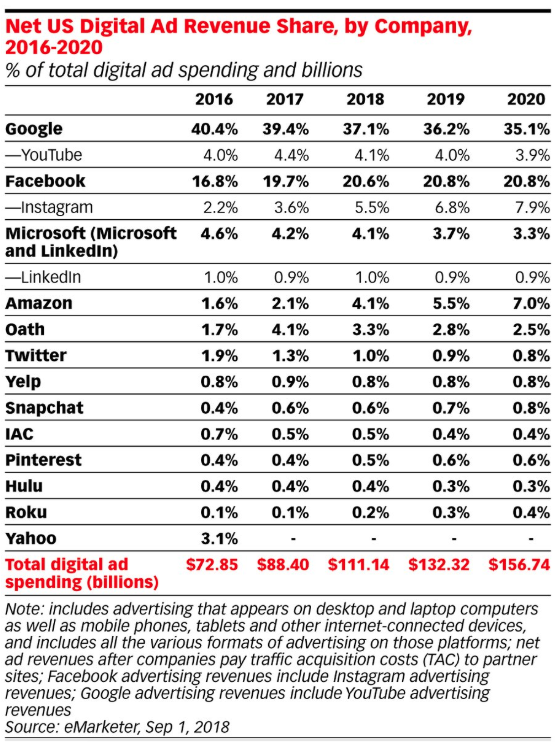Americans’ trust in major news organizations, the amount of bandwidth Netflix streaming consumes, programmatic’s share of the digital display advertising market, the state of mobile video globally, and more are covered in this month’s installment of TFP’s Media Metrics roundup.
To help you keep up with trends and prepare for changes just around the corner, each month we compile excerpts from some key reports covering issues affecting the publishing and media industries. Here are our top picks.
 Here’s How Much Americans Trust 38 Major News Organizations (Nieman Lab)
Here’s How Much Americans Trust 38 Major News Organizations (Nieman Lab)
- In a survey that asked respondents if they trust 38 different news outlets, the bottom six (meaning the least trusted) are all highly partisan digital-native sites—three conservative, three liberal.
- The Wall Street Journal was cited the most trusted, followed by major networks (ABC, NBC, CBS, BBC), national newspapers (New York Times, Washington Post, USA Today), and wire services.
- Fox News came in behind all the other cable and network news outlets. Still, 44.7% of respondents said they trust it as a news source.
- Some 13% of survey respondents said they don’t trust any news organizations at all.
Netflix Viewing Eats Up World’s Data (BBC)
- Netflix video streaming accounts for 15% of the world’s Internet traffic, according to bandwidth management company Sandvine, making it “the world’s most data-hungry application.”
- Meanwhile, video embedded on websites consumes 13.1% of bandwidth, followed by video streaming via YouTube at 11.4% and web browsing at 7.8%.
- 58% of the total volume of downstream Internet traffic is from video, the research found, followed by web browsing at 17%, gaming at 7.8%, and social media at 5.1%.
- Netflix accounts for as much as 40% of all download traffic in the U.S. during evening peak hours, the report says.
The State of Mobile Video (September 2018) (OpenSignal)
- In a global study of mobile video quality, 11 of 69 countries analyzed earned a “very good” rating, though no country achieved an “excellent” rating.
- Of the 11 countries that ranked “very good,” nine were in Europe.
- While South Korea ranked the highest by far in terms of speed, 15 other countries ranked higher in video experience, with the Czech Republic taking the top spot.
Programmatic Is Fastest-Growing Part Of Digital Display (Media Post )
)
- In the U.S. digital display advertising market, programmatic is now the fastest growing segment, according to eMarketer, which projects a 26.3% increase over last year, to $46.55 billion.
- The overall digital display market is expected to expand 25.4%, to $57.42 billion.
- Search will grow at a slightly higher rate (27.7%) to $48.49 billion.
- In terms of the largest digital advertising platforms, the researcher reported that Amazon is now in third place, after Google and Facebook, and will account for 7% of the digital advertising market by 2020.
Using Links to Keep Readers on News Sites (University of Texas Center for Media Engagement)
- In a recent study, link layouts with images drove 63% more clicks than those with text only.
- It also found that links placed at the end of pages resulted in 55% more clicks than those placed in the middle of a page.
- In general, using related content got 14% more clicks than popular content, although the latter drove more clicks when the referral page was Facebook, the study found.
- Simple wording (for example, “Related reading”) generated slightly more clicks than more complicated wording (for instance, “What other people are reading”).
Digital Media Content Consumption Posts 15% Gain (Media Daily News)
- Digital media content consumption on PCs, tablets, and smartphones continued its steady climb last month, growing 15% to 34 billion manhours, according to a recent analysis of Nielsen data.
- Google remained the No. 1 provider, with YouTube, Google, and Waze together accounting for 32.8% of digital media consumed, up from 29.4% last year.
- 56% of growth in overall digital content consumption was on Google platforms, with YouTube alone making up 18% of all digital content consumption.
News Use Across Social Media Platforms 2018 (Pew Research)
- According to an updated Pew report, 68% of American adults “at least occasionally get news on social media,” a number that has held steady since the same time last year.
- However, 57% of those respondents overall expect the news they read on social media to be “largely inaccurate.”
- 72% of Republicans say they expect news on social media to be inaccurate, compared with 46% of Democrats and 52% of Independents.
- 21% of survey respondents say convenience is the top benefit of getting their news on social media, while 8% cite “interactions with other people” as a plus. A very small percentage of those who consume news on social networks say they most like “the diversity of the sources available” (3%) and the ability to customize their content (2%).
Disinformation, ‘Fake News,’ and Influence Campaigns on Twitter (Knight Foundation)
- Recent research shows disinformation on Twitter is still a huge problem post-election, with 4 million tweets linking to fake and conspiracy news outlets in 2017. By comparison, that number stood at 6.6 million in the month leading up to the 2016 election.
- 80% of such accounts were still active as of the release of the research (Oct. 4, 2018), and they continue to publish a million or more tweets every day, according to the report.
- Of the top 10 fake news sites in operation a month before the 2016 election, nine remained in or near the top 10 in 2017.
- The research found bots (automated accounts) made up 33% of the 100 most-followed accounts in the study’s post-election map and 63% of a random sample of all accounts.
Facebook Is Tops with Everyone but Teens (eMarketer)
- Facebook, which grew a slight 0.9% this year, remains the most used social site among all age groups except teens (12 to 17 years old), which increasingly favor Snapchat overall, according to eMarketer research.
- In 2018, the number of teen Facebook users will drop to 11.5 million from 12.1 million last year. By 2022, the number of Facebook users in that age group will fall to 9.3 million. In the same time frame, Snapchat will gain 1.2 million teen users, eMarketer projects.
- Among teens in the U.S., Snapchat is also more popular than Facebook-owned Instagram: 16.4 million users vs. 12.8 million for Instagram.
Media Metrics is a monthly feature from Technology for Publishing aimed at keeping you armed with the latest industry data. If you’d like to share something you’ve read, drop us a note. And keep up with the latest industry news coverage by signing up for our This Week in Publishing emails and our Publishing Innovations newsletter.
Posted by: Margot Knorr Mancini


